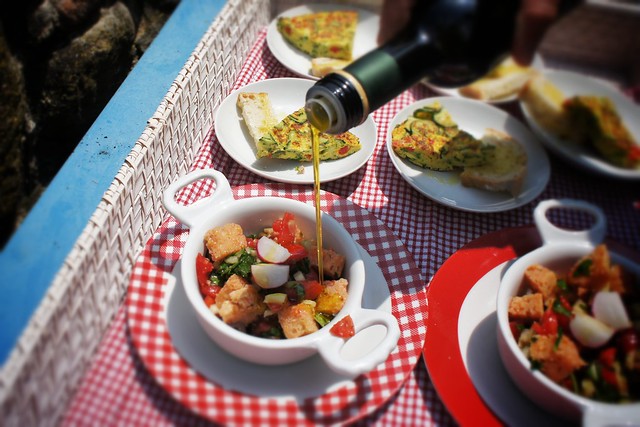When a bottle arrives at your dinner table filled with a deep green, cloudy, viscous liquid with a piquant, zesty, grassy, spritzy, peppery aroma . . .
That’s not your everyday olive oil.
It’s fresh-pressed olive oil. And this is its season.
You can use olive oil right after it’s pressed (typically October-December). But the flavor reaches its peak two or three months after pressing, making January the olive oil season.
Fresh-pressed vs. Extra Virgin: What’s the Difference?
Image: © Concierge in Umbria
Olive oil is at its tastiest and most healthy when it’s young. Both the flavor and nutrients begin to fade after six months and fall flat two years after pressing.
Fresh-pressed olive oil or olio novello is oil less than six months old – the sweet spot. Typically unfiltered, it’s extremely high in polyphenols, a group of antioxidants that are believed to protect cells and prevent diseases such as cancer.
Any type of olive or pressing can be olio novello. It’s not a qualitative designation like extra-virgin, which refers to low acidity oil produced purely through mechanical extraction like stone oil mills (as opposed to chemical extraction, which produces refined oil). While producers will label their new oil olio novello, the only way to tell that it’s still fresh when you get your hands on it is to check the harvest date printed on the bottom. All Italian oils should have a harvest or best by date listed.
Even though all fresh-pressed oils share certain characteristics that differentiate them from older oils, there’s a huge variation in flavor. Some are bold and assertive, others nuanced and delicate.
Using and Storing Fresh-pressed Olive Oil

Image: © Concierge in Umbria
Fresh-pressed olive oil is not for cooking. Heat breaks down its polyphenols, causing it to lose not only flavor, but also health benefits. Ambient heat and light can have the same effects, so only buy olive oil that is bottled in dark glass bottles and kept in a cool place away from direct sunlight.
When you bring your oil home, also keep it somewhere dark and cool, though not necessarily as cold as the refrigerator. By all means, don’t keep it in a clear glass bottle by your stove or on your table any longer than necessary for cooking and serving.
A drizzle on top of soup, a hearty dose over carpaccio, salad, or pasta, or the perfect bruschetta flavoring, fresh-pressed olive oil should be enjoyed as a topping or finishing agent.


